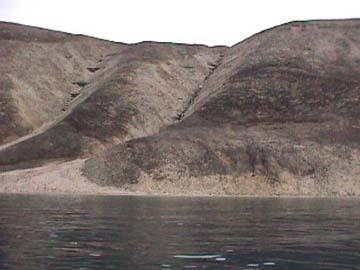
|
|
22 August, 2000
I woke up at 6AM as Mas Ole was returning from checking the net. We talked
about hunting as survival, not tradition. He talked about being stranded
on an ice flow with some other hunters and having to wait for days until it
reconnected so they could get to land again. I asked about polar bears and
he said they were hunted in Washington Land farther to the north or near
Kap York in the south (this was our second study site); we dozed off
again. When I looked at my watch again it said 12:55PM. I thought it must
be broken, but Mas Ole agreed. I got up and measured the fish that "we"
had caught in the net. Cut off and bagged their heads, then washed my
hands--they were frozen numb with cold. I went back inside the tent and
ate some hot lunch that Mas Ole had prepared: split pea soup, cheese,
biscuits, and tea. I packed up my gear and took another walk with the
video camera.
When I returned Mas Ole and I went to haggle for more fish heads with the
local fishermen. I spent all the Kroner that Dr. Radtke had given me for
around 23 fish heads. I measured the total length, cut off their heads,
and bagged them with a data card as I had done the others. On my return
Mas Ole had already broken camp and collected the net. We got in the boat
and headed to the other side of the bay to visit with his girl friend's
family.
They greeted us and invited us to eat with them. They had fried up some
char and made a fish head curry sauce with mashed potatoes. I took my own
eating utensils, which I now realized were an essential thing to have when
you go and visit. I dished up some food, sat down and listened while Mas
Ole translated bits of the disscussion for me. They were talking about the
fishing this year and in years past. One of the older men said that when
he was a boy, the fish were as long as from his foot to his thigh, probably
about 2.5-3 feet. We were all impressed. I enjoyed the char, which tasted
like pink rainbow trout, and the warmth of the company. I waundered over
to take videos of the dip net fishing technique before we bid our goodbyes
and left the river and Mac Cormick bay for Qaanaaq.
It was a rough ride back, but I was getting used to the motion of the boat
and since it was drizziling I tucked my self underneath the bow, resting my
body on all of our gear and fell asleep. Suddenly I felt the boat stop and
heard the sound of a gun being loaded. I opened my eyes to find Mas Ole
motioning across the water toward the eastern side of the sund. He said
seal. My heart was beating wildly; part of me was afraid for the seal and
the other part was excited that I was actually going to see a seal hunt.
We waited patiently for the seal to resurface. It never did and Mas Ole
emptied his gun shooting at some sea birds with no luck.
We traveled on for another hour or so before we slowed down again. This
time we were met by Wendy and Anderson, with another hunter, Frank and his
dog; they were on their way to the river to fish and to rendevous with us
two days later when we would return by helicopter to Lake Tassersuit. We
handed over the satellite phone and the gill net.
We arrived back to Qaanaaq around 8:00PM. I carted my gear and the 33 fish
heads back to the Alderhous, stopping a few times as I trudged up the hill
in my fishing boots. As Anderson's room was empty, I went and got the rest
of my gear to move in until the trip to the lake. I met with Dr. Radtke
and Josh to tell him about the samples I got. He informed me that John's
gear still hadn't arrived because of fog conditions. John also couldn't
get to Qaanaaq for the same reason. We commented on how we were at the
mercy of the weather and I remembered how Mas Ole had commented that
knowing the weather, how to read the weather, was essential to surviving up
here. Hunters were respected for their expertise in reading conditions.
Tornge Kavigak', the lady that runs the rest home, made sure I had some
soup, bread, and tea before I showered and fell into bed exhausted. I
nestled into my Danish style quilt and felt in the lap of luxury just
having this bed, a clean body, and clean clothes.

No seal to be seen.

Contact the TEA in the field at
.
If you cannot connect through your browser, copy the
TEA's e-mail address in the "To:" line of
your favorite e-mail package.
|
